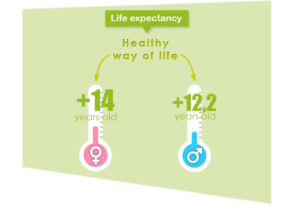What foods can help the elderly people stay at home?
3 November 2020
According to 2019 INSEE estimations, people over 75 years old represent up to one tenth of the French population.1 Among them, only 10% attend or live in a retirement home for elderly people.2 Therefore the majority of this population remains at home with varying dependencies.

With age, we can see lifestyle changes due to physical capacities decline and psychological state evolution. This may result in a decrease of physical activities and a dietary intake reduction. Weight loss can be important, which is not without risk for elderly people: diseases such as sarcopenia or osteoporosis could appear. 3 4
So, it is essential to provide food products designed for elderly people to ensure that their dietary intake remains adequate. Indeed, these can be important in order to maintain adequate dietary intakes and therefore maintain a healthy lifestyle.
An American statistical study of 2018 revealed that a healthy lifestyle (good and adequate eating habits, moderate alcohol consumption, etc…) could potentially increase life expectancy by 12.2 years for men and 14 years for women.5 For comparison, the average life expectancy in the United Stated is 78.5 years old (2017 data).6

Why do we need products that are “adapted” to elderly people? Are common products not enough?
Common food products should of course not be removed. But a lot of studies demonstrate that dietary intake strongly tends to decrease with age. 3 7 8 9 Between 20 and 80 years old, we estimate that energy intake decreases about 600 and 1 300kcal respectively for women and men. 10 This represents an average energy intake reduction of up to 50%. Such a decrease is not without any consequences for the body: cognitive and physical capacities reduction, fatigue increase, weakening of the immune system, etc… Indeed, a 2018 meta-analysis showed that the quality of life of older adults was directly associated to their eating habits. 11
Consequently, dietary supplements can be necessary in order to better cover energy need of elderly people. Then, three types of products exist:
- Nutritional supplement; they can be useful to provide vitamins, minerals and other essential nutrients such as omega-3. The main disadvantage of these is that they can be difficult to swallow for some elderly people, especially those with dysphagia (swallowing difficulties). Moreover, these products may be seen as drugs by elderly people. This is the reason why some aversion may be observed.
- Functional foods, i.e. foods that appear to be similar to conventional foods, but they contain one or more health benefits nutrients.12 These foods can often contain a concentrate of essential nutrients. For example, they can be presented as dairy beverage, dessert cream or even soup.
- Finger-food products; these are traditional foods but with a shape and a consistency that allowed them to be eaten with fingers. These foods will usually be a concentrate of energy and essential nutrients. The advantage of these products is the fact that they are simple to eat for older adults with difficulties to use fork and knife (such as patients with Parkinson’s disease). Moreover, they can be easily added in a dish or be consumed at any time of the day without necessarily being at the dinner table.

What are the most important nutrients for these products adapted to elderly people?
We have already seen that energy intake of elderly people is often insufficient. Consequently, a product intended for this population could be concentrate in energy. Then it could be richer in fats, because lipid is the most energetic nutrient: carbohydrates and proteins approximately represent 4kcal/g while lipids represent 9kcal/g. Concerning the quality of these lipids, it would be ideal to maximize omega-3 since it is an essential fatty acid that is too little present in the traditional diet. Various epidemiological studies have shown that increased consumption of omega-3 would reduce the risk of stroke as well as cognitive declines. 10 13 14
Proteins are also extremely important for elderly people because they help maintain bone and muscle mass integrity. This allows this population to better preserve their physical capacities. For more information, we talk about this topic in several blog article:
- “What are the protein needs of the elderly?“
- “What is the perfect protein for the elderly people?“
- “How are proteins beneficial to bone health?“

With age, anabolic A resistance can occur. In other words, a small quantity of proteins could not be enough to stimulate muscular synthesis.15 However, it is still possible to counterbalance the phenomenon by providing a biggest quantity of essential amino acids B, especially Leucine, the most important amino acid to enhance anabolism.16 17 Therefore, a dose of between 2 and 3g would represent the minimum amount per food intake to properly stimulate muscular synthesis in the elderly people. 15 18 19
Furthermore, it is important to notice that food alone is not enough: physical activity (even walking) is essential in order to maintain the muscle stimulation. For more information, please see our article on protein needs of elderly people.

The addition of micronutrient can also be important. According to recommendations from the 2016 review “Nutrition recommendations in elderly and aging. Medical Clinics of North America”, the lack of certain nutrients may pose a health risk. Nutrients that are commonly deficient are vitamin D and B12, and Calcium. These are the three micronutrients to be included as a priority in products for elderly people.19
If food products are more energetic, are elderly people likely to eat less?
No, they are not, provided that the dish volume does not change. A study conducted in a hospital on 36 patients aged from 52 to 96 years old found that the food volume ingested between a regular dish and a dish with a higher energy density is negligible. Therefore, it is possible to significantly increase energy intake by providing food products high in energy. 20
What foods should be included in these products adapted to elderly people?
Not all foods are suitable for elderly people. Not for health reasons, but simply for the hedonic side of the product. As we have seen earlier, there is often an appetite decline with age. That is the reason why the product must be as appetizing as possible so that the elderly person wants to consume it.8
A 2008 study of the Journal of Nutrition Health and Aging indicates that the more negative emotion is generated by food (disgust, indifference, worry, doubt, frustration, disappointment, fatigue), the greater the risk of undernutrition may be. So, it appears essential to choose foods that generate positive emotions in this population. 21
What foods can elicit these positive emotions in elderly people?
A 2006 study shows that elderly people’s favorite dishes seem to be foods they are familiar with, with a traditional way of preparation. So, we have to forget overelaborated methods of preparation and exotic foods. It Is important to use what they know well and appreciate. 22
Therefore, flavorings should always remain simple: vanilla, chocolate, caramel, coffee… Furthermore, sensory abilities often decrease with age. As taste and smell may weaken, it seems necessary to raise the flavors of foods more and to propose stronger aromas than those traditionally used.
Do these foods have to meet specific requirements?
In addition to the nutrition and hedonic aspect, these products must have a shape and a texture adapted. Indeed, elderly people can have certain diseases such as dysphagia or xerostomia (oral dryness). That is why product should have a particular texture. 23
It can be a good idea to make products in small portion form so that they can be eaten without cutlery. To this extent, finger-food products can be very interesting.

As a conclusion, to be perfectly adapted to elderly people, a food product must:
- Be energetic and source of essential nutrients, especially vitamins (D and B12), minerals (calcium) and proteins. Moreover, for proteins, it is important to choose a Leucine-rich one. That is the reason why dairy proteins can be very interesting: whey proteins contain 11.7% of Leucine, and micellar caseins 9.2%. *
- Be attractive, it must generate positive emotions. But it should not be too extravagant: older people generally prefer products that are familiar to them.
- Be easy to consume, with a suitable texture and shape (not too hard, not too dry for example)
*A [Anabolism]: Muscular protein synthesis
*B [Essential Amino Acids]: Amino acid that the body cannot synthesize. Therefore, they must be supplied through the diet
*data for Leucine correspond to those measured in Prodiet® 80S for whey proteins and Prodiet® Fluid for micellar caseins. These products are developed by Ingredia.
For more information and any inquiry, contact us.
Authors: Rémi Maleterre & Audrey Boulier.
_________________________________________________________________________________________
[1] “Population Par Âge − Tableaux de l’économie Française | Insee,” accessed April 9, 2020, https://www.insee.fr/fr/statistiques/3676587?sommaire=3696937.
[2] DREES, “728 000 Résidents En Établissements d’hébergement Pour Personnes Âgées En 2015,” Études & Résultats, 2015, https://drees.solidarites-sante.gouv.fr/IMG/pdf/er1015.pdf.
[3] Sonya Brownie, “Why Are Elderly Individuals at Risk of Nutritional Deficiency?,” International Journal of Nursing Practice 12, no. 2 (2006): 110–18, https://doi.org/10.1111/j.1440-172X.2006.00557.x.
[4] Alfonso J. Cruz-Jentoft et al., “Prevalence of and Interventions for Sarcopenia in Ageing Adults: A Systematic Review. Report of the International Sarcopenia Initiative (EWGSOP and IWGS),” Age and Ageing 43, no. 6 (November 1, 2014): 748–59, https://doi.org/10.1093/ageing/afu115.
[5] Yanping Li et al., “Impact of Healthy Lifestyle Factors on Life Expectancies in the US Population,” Circulation, July 2018, https://doi.org/10.1161/CIRCULATIONAHA.117.032047.
[6] “Indicateurs de Développement Dans Le Monde – Google Public Data Explorer,” accessed August 30, 2020, https://www.google.com/publicdata/explore?ds=d5bncppjof8f9_&met_y=sp_dyn_le00_in&idim=country:USA:GBR:CAN&hl=fr&dl=fr#!ctype=l&strail=false&bcs=d&nselm=h&met_y=sp_dyn_le00_in&scale_y=lin&ind_y=false&rdim=world&idim=country:USA&ifdim=world&hl=fr&dl=fr&ind=false.
[7] J. E. Morley, “Decreased Food Intake With Aging,” The Journals of Gerontology Series A: Biological Sciences and Medical Sciences 56, no. Supplement 2 (October 1, 2001): 81–88, https://doi.org/10.1093/gerona/56.suppl_2.81.
[8] Anna Pilgrim et al., “An Overview of Appetite Decline in Older People,” Nursing Older People 27, no. 5 (June 2015): 29–35, https://doi.org/10.7748/nop.27.5.29.e697.
[9] Lorenzo M. Donini, Claudia Savina, and Carlo Cannella, “Eating Habits and Appetite Control in the Elderly: The Anorexia of Aging,” International Psychogeriatrics 15, no. 1 (March 2003): 73–87, https://doi.org/10.1017/S1041610203008779.
[10] Riccardo Calvani et al., “Current Nutritional Recommendations and Novel Dietary Strategies to Manage Sarcopenia,” The Journal of Frailty & Aging 2, no. 1 (2013): 38–53.
[11] Thara Govindaraju et al., “Dietary Patterns and Quality of Life in Older Adults: A Systematic Review,” Nutrients 10, no. 8 (July 26, 2018), https://doi.org/10.3390/nu10080971.
[12] karine Pierre-Lecocq, “Aliment fonctionnel,” CERIN, accessed April 9, 2020, https://www.cerin.org/glossaire/aliment-fonctionnel/.
[13] Institute of Medicine (US) Food Forum, Nutrition Concerns for Aging Populations, Providing Healthy and Safe Foods As We Age: Workshop Summary (National Academies Press (US), 2010), https://www.ncbi.nlm.nih.gov/books/NBK51837/.
[14] Natalia Ubeda, María Achón, and Gregorio Varela-Moreiras, “Omega 3 Fatty Acids in the Elderly,” The British Journal of Nutrition 107 Suppl 2 (June 2012): 3, https://doi.org/10.1017/S0007114512001535.
[15] Benoit Smeuninx et al., “Age-Related Anabolic Resistance of Myofibrillar Protein Synthesis Is Exacerbated in Obese Inactive Individuals,” The Journal of Clinical Endocrinology and Metabolism 102, no. 9 (July 14, 2017): 3535–45, https://doi.org/10.1210/jc.2017-00869.
[16] Imanipour Vahid et al., “The Effects of Branch-Chain Amino Acids on Fatigue in the Athletes,” Interventional Medicine & Applied Science 10, no. 4 (n.d.): 233–35, https://doi.org/10.1556/1646.10.2018.10.
[17] Joshua C. Anthony et al., “Orally Administered Leucine Stimulates Protein Synthesis in Skeletal Muscle of Postabsorptive Rats in Association with Increased EIF4F Formation,” The Journal of Nutrition 130, no. 2 (February 1, 2000): 139–45, https://doi.org/10.1093/jn/130.2.139.
[18] Christos S. Katsanos et al., “A High Proportion of Leucine Is Required for Optimal Stimulation of the Rate of Muscle Protein Synthesis by Essential Amino Acids in the Elderly,” American Journal of Physiology. Endocrinology and Metabolism 291, no. 2 (August 2006): E381-387, https://doi.org/10.1152/ajpendo.00488.2005.
[19] Hope Barkoukis, “Nutrition Recommendations in Elderly and Aging,” The Medical Clinics of North America 100, no. 6 (November 2016): 1237–50, https://doi.org/10.1016/j.mcna.2016.06.006.
[20] Ann Ödlund Olin et al., “Energy-Enriched Hospital Food to Improve Energy Intake in Elderly Patients,” Journal of Parenteral and Enteral Nutrition 20, no. 2 (1996): 93–97, https://doi.org/10.1177/014860719602000293.
[21] Issa Narchi et al., “Emotions Generated by Food in Elderly French People,” The Journal of Nutrition, Health & Aging 12 (February 1, 2008): 626–33, https://doi.org/10.1007/BF03008273.
[22] M. Laureati et al., “Sensory Acceptability of Traditional Food Preparations by Elderly People,” Food Quality and Preference, The First European Conference on Sensory Science of Food and Beverages: “A Sense of Identity,” 17, no. 1 (January 1, 2006): 43–52, https://doi.org/10.1016/j.foodqual.2005.08.002.
[23] E. Rothenberg and K. Wendin, “7 – Texture Modification of Food for Elderly People,” in Modifying Food Texture, ed. Jianshe Chen and Andrew Rosenthal (Woodhead Publishing, 2015), 163–85, https://doi.org/10.1016/B978-1-78242-334-8.00007-9.